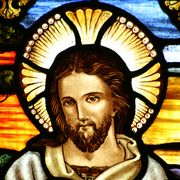Latter Day Saint movement
The Latter Day Saint movement is a group of religious denominations and adherents who follow at least some of the teachings of Joseph Smith, Jr., who published the Book of Mormon in 1830. The Latter Day Saint movement is one of many movements that arose during the Second Great Awakening in 19th-century United States. Many of these movements, including the Latter Day Saints movement, were strongly restorationist in outlook and sought to transcend Protestant denominationalism and to restore a form of Christianity thought to be more consistent with the New Testament.
The original church founded by Smith was known initially as the Church of Christ, then the Church of the Latter Day Saints to distinguish it from other Christian churches, and by 1838 as the Church of Jesus Christ of Latter Day Saints. After Smith's death in 1844, the organization divided into several groups, the largest of which, The Church of Jesus Christ of Latter-day Saints (LDS Church) migrated to the Great Basin—which soon became the Utah Territory—and became known in the 19th century for its practice of plural marriage. The LDS Church officially renounced this practice in 1890 and discontinued it completely in the early 20th century. Other denominations, who refer to themselves as Mormon fundamentalists, continued the practice.
Other groups originating within the Latter Day Saint movement followed different paths in Missouri, Illinois, Michigan, and Pennsylvania. For the most part these groups rejected plural marriage and some of Smith's later teachings. The largest of these, the Community of Christ (originally known as the Reorganized Church of Jesus Christ of Latter Day Saints), was formed in Illinois in 1860 by several groups uniting around Smith's son, Joseph Smith III. Most denominations existing today that adhere to the teachings of Smith have some historical relationship with the movement.
Contents |
Brief history
The driving force behind and founder of the Latter Day Saint movement was Joseph Smith, Jr., and to a lesser extent, during the movement's first two years, Oliver Cowdery. Throughout his life, Smith told of an experience he had as a boy having seen God the Father and Jesus Christ as two separate beings, who told him that the true church had been lost and would be restored through him, and that he would be given the authority to organize and lead the true Church of Christ. Smith and Cowdery also explained that the angels John the Baptist, Peter, James and John visited them in 1829 and gave them authority to reestablish the Church of Christ.
The first Latter Day Saint church was formed in April 1830, consisting of a community of believers in the western New York towns of Fayette, Manchester, and Colesville. They called themselves the Church of Christ. On April 6, 1830, this church formally organized into a legal institution under the name Church of Christ. By 1834, the church was being referred to as the Church of the Latter Day Saints in early church publications,[1] and in 1838 Joseph Smith announced that he had received a revelation from God that officially changed the name to the Church of Jesus Christ of Latter Day Saints.[2][3]
In 1844, William Law and several other Latter Day Saints in church leadership positions publicly denounced Smith's secret practice of polygamy in the controversial Nauvoo Expositor, and formed their own church. The city council of Nauvoo, Illinois subsequently had the printing press of the Expositor destroyed. In spite of Smith's later offer to pay damages for destroyed property, critics of Smith and the church considered the destruction heavy-handed. Some called for the Latter Day Saints to be either expelled or destroyed. Following Smith's assassination by a mob in Carthage, Illinois, some prominent members of the church claimed to be Smith's legitimate successor. These various claims resulted in a succession crisis, in which the majority of church members followed Brigham Young, he being the senior Apostle of the church; others followed Sidney Rigdon or James Strang. The crisis resulted in several permanent schisms as well as the formation of occasional splinter groups, some of which no longer exist. These various groups are occasionally referred to under two geographical headings: "Prairie Saints" (those that remained in the Midwest United States) and "Rocky Mountain Saints" (those who followed Brigham Young to what would later become the state of Utah).
Today, there are many schism organizations who regard themselves as a part of the Latter Day Saint movement, though in most cases they do not acknowledge the other branches as valid and regard their own tradition as the only correct and authorized version of Smith's church. The vast majority of Latter Day Saints belong to the largest denomination, The Church of Jesus Christ of Latter-day Saints (LDS Church) which claims 13 million members worldwide. The second-largest denomination is the Community of Christ, which reports over 250,000 members. The third largest is The Church of Jesus Christ, with fewer than 13,000 adherents.


Usage of the term Latter Day Saint
Origin
The first known use of the term Latter Day Saint was in 1834, shortly before the Church of Christ was informally renamed "the Church of the Latter Day Saints" to distinguish it from other "Churches of Christ" that were being established at the time.[4] The term derives from Smith's teaching that adherents of the religion God established were "saints" in the same sense that Paul of Tarsus used the term, meaning that they were followers of Christ. They are termed latter day saints in order to distinguish them from the saints of the early Christian church (former day saints).[5] The church adopted the term officially April 16, 1838 with a revelation delivered through Smith, "For thus shall my church be called in the last days, even the Church of Jesus Christ of Latter Day Saints."[2][3]
Latter Day Saint vs. Latter-day Saint
The British styling Latter-day Saint—including both the hyphenation and lower-case d—came into common use in about 1852 when The Church of Jesus Christ of Latter-day Saints was incorporated by that name in Salt Lake City, Utah. This form is used only by that denomination, and its usage and the abbreviation LDS generally denote only members of that church.
Because the LDS Church is by far the largest and most well-known of the various Latter Day Saint denominations, a number of churches who consider themselves Latter Day Saints have informal terms that refer to their members, in order to avoid confusion. For example, the denomination that is officially named the Church of Jesus Christ of Latter Day Saints refers to itself informally as the Strangites. Similarly, members of the Church of Christ (Temple Lot) are often referred to as Hedrickites, and members of The Church of Jesus Christ are often called Bickertonites. In 2001, the Community of Christ, the second largest Latter Day Saint denomination, changed its name from the Reorganized Church of Jesus Christ of Latter Day Saints, while retaining the longer name for legal purposes, partly to avoid these types of confusions, although they have always referred to members as saints and the church informally as the Saints' Church.[6] Nevertheless, the term Latter Day Saint may be appropriately applied to all denominations within the Latter Day Saint movement.
Latter Day Saint vs. Mormon
Latter Day Saints are commonly referred to as Mormons, a nickname derived from the title of the Book of Mormon. However, the size and prominence of the LDS Church have led to the terms Mormon and Mormonism being generally understood to apply only to the church and its members—that is, to the Latter-day Saints. The desire of the church to emphasize doctrinal teaching of Jesus Christ has led to its urging journalists to use the terms Latter-day Saint and Mormon only in reference to members of the church or as an adjective in such expressions as Mormon pioneers, while referring to the church as either The Church of Jesus Christ of Latter-day Saints or the shortened form, the Church of Jesus Christ.[7] The Associated Press Stylebook states the following concerning the use of the term Mormon: “The term Mormon is not properly applied to the other Latter Day Saint churches that resulted from the split after [Joseph] Smith’s death.” Nevertheless, the term is often used to refer to adherents of Mormon fundamentalism[8] who believe in plural marriage (a practice that the LDS Church officially abandoned in 1890), as well to refer to other Brighamite sects within the Latter Day Saint movement such as the Restoration Church of Jesus Christ and others.
See also
- Mormonism and Christianity
- Criticism of Mormonism
- Succession crisis
Notes
- ↑ See, e.g., Joseph Smith, Jr. (ed), Doctrine and Covenants of the Church of the Latter Day Saints (Kirtland, OH: F.G. Williams & Co., 1835).
- ↑ 2.0 2.1 Manuscript History of the Church, LDS Church Archives, book A-1, p. 37; reproduced in Dean C. Jessee (comp.) (1989). The Papers of Joseph Smith: Autobiographical and Historical Writings (Salt Lake City, Utah: Deseret Book) 1:302–303.
- ↑ 3.0 3.1 H. Michael Marquardt and Wesley P. Walters (1994). Inventing Mormonism: Tradition and the Historical Record (Salt Lake City, Utah: Signature Books) p. 160.
- ↑ See "Minutes of a Conference", Evening and Morning Star, vol. 2, no. 20, p. 160.
- ↑ A. Theodore Tuttle, “The Message of the Restoration,” Ensign, June 1971, p. 69.
- ↑ Peter Judd and Bruce Lindgren (1976). Introduction to the Saints Church. (Independence, Mo.: Herald House. ISBN 0964069601).
- ↑ LDS Style Guide
- ↑ The term "Mormon fundamentalist" appears to have been coined in the 1940s by Apostle Mark E. Petersen: Ken Driggs, "'This Will Someday Be the Head and Not the Tail of the Church': A History of the Mormon Fundamentalists at Short Creek", Journal of Church and State 43:49 (2001) at p. 51.
References
- Danny L. Jorgensen, "Dissent and Schism in the Early Church: Explaining Mormon Fissiparousness", Dialogue: A Journal of Mormon Thought, vol. 28, no. 3 (Fall 1993) pp. 15–39.
- Steven L. Shields, Divergent Paths of the Restoration: A History of the Latter Day Saint Movement Los Angeles: 1990.
External links
 Media related to Latter Day Saints at Wikimedia Commons
Media related to Latter Day Saints at Wikimedia Commons The Wiktionary definition of Latter-Day Saint
The Wiktionary definition of Latter-Day Saint Works related to Category:Mormons at Wikisource
Works related to Category:Mormons at Wikisource
|
||||||||||||||||||||||||||
|
|||||||||||||||||||||||||||||

